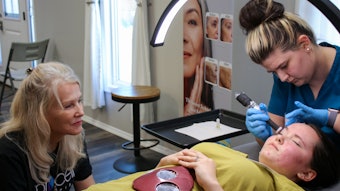Management and leadership issues are the No. 1 time-consuming focus of every spa owner. A business is only as good as the people who work within it, and having a team of star employees is one of the greatest accomplishments an owner can ever achieve. However, it doesn’t happen by accident. It requires diligent planning from the beginning.
Establish a vision
The most important motto an owner should adopt when building a team is to hire hard and manage easy. Spa managers who hire out of desperation, not inspiration, will have serious management challenges that cost time, effort and money. It is better to hold out for the right person who fits into your established spa culture and meets all the job skill requirements.
When assembling your team of star employees, the first step is to identify what qualities each member needs to possess. Clearly define these characteristics and attributes. Write a vision statement that describes a star employee. Remember to be specific. To get what you want, it is important to pinpoint what is essential. The statement should include how employees would act and present themselves, how they would interact with others, what motivations they would have concerning their career and what type of educational background they would bring to the table.
Ask yourself the following questions: What possibilities are created when you define what type of team members you are looking for? What barriers arise when there is no framework or criteria for hiring? How would you remain committed in supporting your ideals? What could steer you off-track and cause you to hire the wrong individuals? Finding the answers to these questions will help you stick to your game plan.
Essential employee traits
There are 15 specific non-negotiable traits you need to look for in a star employee. In addition, three more criteria to keep in mind are each applicant’s knowledge, skills and attitude. Although knowledge and skills can be learned, a team member must arrive with the right attitude.
When interviewing, look for the following characteristics that comprise the framework of a star employee, and use them to build the basis of integral interview questions and processes. See Key Questions to Ask to decide what qualities are the most important among your team members.
1. A positive outlook
2. The desire for continuing education
3. Self-motivation and the pursuit of excellence
4. Honesty and integrity
5. Punctuality
6. An impressive résumé
7. Detail-oriented
8. A professional appearance and image
9. The ability to be a team player
10. Great communication skills
11. Good conflict-resolutionskills
12. A passion for the esthetic industry
13. Openness to change and to new experiences
14. The desire for a career, not just a job
15. Consistent work habits
The recruitment environment
When recruiting, the more innovative, consistent and aggressive you are, the more likely you will be to find the right kind of team members. Hiring is a 24/7 process, and all businesses should accept applications and conduct interviews regularly, regardless of whether positions currently are available. Staffing needs can change rapidly.
Before recruitment can take place, make sure that you have established your business in the market, as well as created an appropriate environment that is conducive to long-term employment in order to attract the ideal and best team members. There are two specific reasons why people most often leave companies. First, employees feel disgruntled, unappreciated, unable to advance, creatively stifled or unfairly treated. Secondly, they believe that they are underpaid for the creative talent or amount of work they provide.
Remain proactive in these areas in order to reduce your turnover dramatically. Good employees seek unlimited income-earning potential, an enjoyable work environment and ongoing education to keep them motivated. Provide programs and initiatives that support these goals.
Hiring for beginners
A common frustration for spa owners and managers is finding qualified applicants. The following include various recruiting options to try when seeking new employees.
Classified screening. Advertising should be as specific as possible and provide enough information to eliminate those individuals who are not suitable for the position, as well as entice promising candidates. In order to carefully sift through applicants, have classified respondents call into a voice mail system to leave a first-impression message. Or ask them to fax or e-mail a résumé to preview their work history and determine if there is a match with your culture and mission. Contact applicants who sound enthusiastic and professional, or who have the sought-after requirements to participate in a pre-screen call.
Internet marketing. Think of Web job sites, such as CareerBuilder.com, Monster.com and Craigslist.com, as hiring tools at your disposal. The Internet can be affordable and offer a broader reach to attract star team members.
Network recruitment. Use your business contacts and clients as a starting point for finding people who are looking for a job. Talk with individuals you trust to see if they know anyone who fits the bill. Spread the word that you’re looking to fill a position.
Recruiting out of schools. One solution that many spa owners utilize is to recruit individuals right out of cosmetology or esthetic school. Contact local institutions to inform new graduates of possible job opportunities.
Interviewing for dummies
The interview process should be structured and time-efficient. It is important to understand clearly the essential steps. Preparing powerful questions and demonstrating good listening skills also will be extremely beneficial during an interview conversation. Be aware of how you listen, and notice if you become distracted, as this can cause you to form opinions about candidates and their job skills. Applicants should provide clear, direct responses to all interview questions. Following is an example process that starts with recruitment and ends with hiring.
Pre-screen call. Spend five minutes on the phone with an individual, and ask about five short questions. See Key Questions to Ask for some ideas. If the person would not be an appropriate fit, thank them for their time.
In-person interview. If the pre-screen call is successful, invite the candidate to your spa for a 15-minute in-person interview. During that time, look for a well-groomed and fashionable image that fits into the culture of your spa. Job candidates should try to impress you with their presentation because up to 10 different factors are noticed in the first 10 seconds of meeting a person. Nonverbal factors include whether the person is nice or not, as well as their education and intelligence levels, and family background.
Notice nonverbal communication, such as good eye contact and open body language. Nonverbal cues make up 60% of all communication and can say more than actual words. Listen to the person’s tone and outlook. Are they coming across positively or negatively? Discuss why the applicant is seeking new employment, and ask them to elaborate on their career visions for the next five years. If the person doesn’t appear to meet your expectations, thank them for their time.
Professional references. If the candidate still shows potential, call at least three of their professional references.
Second interview. If the references check out positively, invite the person back for a second interview. Choose an outside location for this meeting, such as a coffee shop or restaurant. This will enable you to remain focused and uninterrupted, as well as to look for consistency in the person’s communication and image. Reconfirm your positive impressions from the first interview. Continue the use of interview questions, discuss the pay structure and compensation, and, if appropriate, set up a technical interview.
Technical interview. At this session, the candidate will demonstrate their abilities in providing services. For example, you could have an applicant bring in three models to perform a facial, body treatment and peel. By procuring models, a definite interest in working for your organization is shown, and it reveals a person’s client service skills, speed and accuracy. Another option would be for the candidate to practice on three existing staff members to truly gauge the quality of their skills.
Hiring. After successfully completing the technical interview, extend an invitation to the applicant to join the team. Also set aside time for the individual to review and sign the employee manual and other documents, as well as to discuss the job description appropriate for the position.
Set clear expectations
When working with your team members, it is important to have conversations concerning your expectations. People thrive when they have a structure to follow. Before beginning their first day of work, each team member should be presented with an employee manual and a job description detailing the duties required and the level of performance expected, as well as stating what is anticipated from management. There is a great benefit to producing a company manual or philosophy that details the company mission statement, policies and rules of conduct. In addition, when discussing job descriptions, listen for opportunities to ask powerful questions that will motivate your employees to search deeply for what is important to them.
When creating these structures, ask yourself the following questions: What are the benefits of having an employee manual and job description for each employee? How will you maintain accountability as you coach new hires? How will you support your employees to understand the importance of a commitment to excellence and how it will affect their future career?
Maintaining enthusiasm
Incentives are essential in sustaining focus and passion for the job. Programs that are conducted daily, weekly or monthly—at the longest—work best. Incentives that last longer tend to lose momentum and excitement among team members. If you set up an incentive as a game and make it fun, you will inspire your staff to make a difference in its retail recommendations.
Spa dollar rewards program. This program rewards individuals with spa dollars for meeting their performance goals. You can reward your staff members in four goal areas.
• Meet your service sales goal weekly—Earn 20 spa dollars.
• Meet your retail sales goal weekly—Earn 20 spa dollars.
• Obtain referrals—Earn 2 spa dollars for each card returned.
• Complete pre-booking—Earn 1 spa dollar for each pre-booked client.
At the end of each monthly team meeting, hold an auction in which team members can bid on items using their spa dollars. This will ensure attendance, as well as generate excitement and energy. Partner with a distributor to offer desirable prizes, such as cutting capes, styling tools, T-shirts, products, educational CDs and DVDs, or continuing education passes.
Daily incentives. “Pass the Piggy Bank” is a simple, but effective idea to maintain daily interest. Start a bank with $10, and pass it to the technician who made the last sale. Whoever has the bank at a predetermined time at the end of the day gets to keep the money. Another idea is to present the highest-grossing technician with a free lunch from a local restaurant.
Weekly incentives. Meeting weekly goals can be rewarded with free parking, spa dollars for a complimentary product or a free latte every day for a week.
Monthly incentives. A gift certificate to a retail store, a weekend getaway to a bed and breakfast, services at a noncompeting spa, or dinner and a movie are all appealing incentives for longer-term goals.
Other incentive options. Periodically introduce other incentive options to create excitement and focus toward achieving objectives. Try any one of the following ideas.
• Whoever has the largest retail sales percentage increase in one week receives two movie tickets to a local theater.
• The team member with the highest retail sales in one day receives a $20 bonus.
• Those employees who meet retail sales goals can earn paid time off.
Casual motivation
Motivating your staff is the key to moving your business forward. Support your team members by highlighting their achievements, and coach them in areas where they need improvement so that everyone reaches their highest potential. The goal of casual motivation is to create an environment in which team members are there because they want to be. Although servant leadership is when employees want to make you proud because you are easy to work for and make them feel valued, casual motivation is an entire coaching approach that makes the workplace enjoyable and fun.
Use profiles on team members. Hire the best people, set up parameters of expectations, coach them, keep the lines of communication open and establish goals. Do not use condescension. A great boss does whatever is necessary to keep the business running smoothly, and always is willing to help out and solve challenges without becoming frustrated or dismissive. Casual motivation starts from the top with the owner paying attention and being personable without crossing the boundary into their employees’ personal lives.
People are motivated by many things, such as money or an acknowledgment of a job well done. Be specific with recognition and praise. When used authentically, this skill will empower your employees. As a result, they will strive to do more to receive additional positive affirmation.
Find out what motivates each individual, and use it to coach. It is important to discover each person’s “why.” Why is it important to them to be successful, and how will being successful support their life and business? Clearly defined values, personality traits, job descriptions and incentives will ensure a greater likelihood of you putting together a team of star employees.










